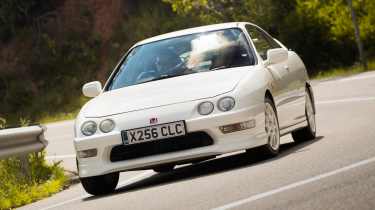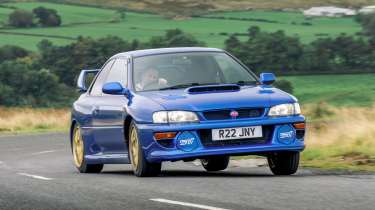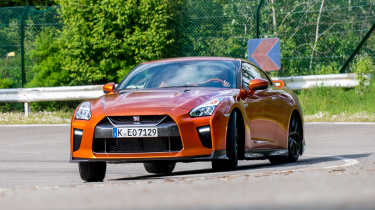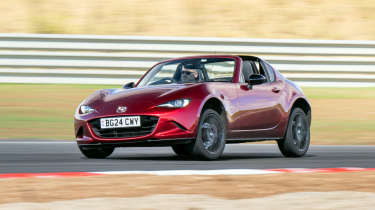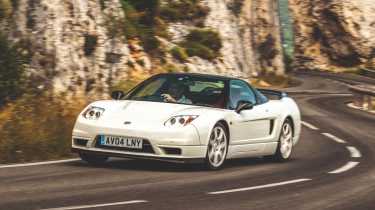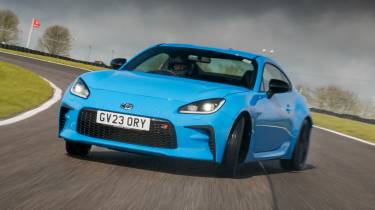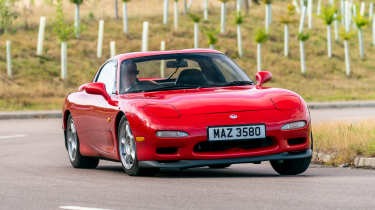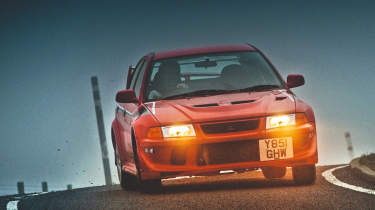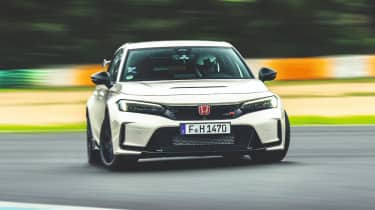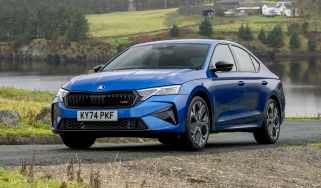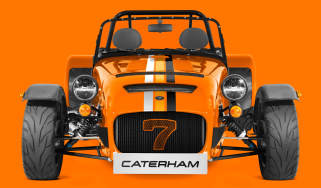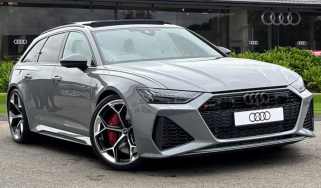Best Japanese cars 2025 – performance icons from the land of the rising sun
The Japanese have produced some of the most compelling performance cars we've ever tested, from hot hatches and rally cars to full-on supercars
The Japanese do things differently when it comes to performance cars. Their approach is one of substance over style – methodical and calculated, majoring on engineering and purpose over superficiality; durability for a lap of Fuji or along a special stage, over plushness, or a premium fit and finish. They push all sorts of boundaries, from revs to retail price. Above all, the Japanese stay wedded unrelentingly to a stated brief. Whether it’s pursuing the more ambiguous, sensational definition of the Thrill of Driving, like the Lexus LFA, Toyota GR86 and Mazda MX-5, or pursuing without compromise raw ability against the clock, like the Nissan GT-R and Honda Civic Type R.
We adore Japanese performance cars. Take ages to get here or outstay their welcome though some might, the depth of their talents is always worth waiting for and always worth sticking around for. Here are our favourites from over the years.
Lexus LFA
We lead with the king in the eyes of many. The Japanese car that could well have the honour of being the only from the East to be truly accepted in the upper echelons of supercardom, at least in posterity. As well it should be, with a bespoke Yamaha-tuned V10 that revs so fast an analogue tacho can’t keep up. The Lexus LFA is the poster child for that camp of Japanese car that takes an age to arrive. It’s what happens when iterative perfectionism goes unchecked at a multinational car company with bottomless pockets and a determined CEO.
>Lexus LFA (2009 - 2012) review – the ultimate Japanese supercar
The irony is, the result was far from perfect, still sporting a lurchy single-clutch paddle-shift transmission at the dawn of the dual-clutch supercar age and priced like a hypercar at £340,000, with only supercar potency, at 552bhp. Some got it straight away while for others it took a while, but objective performance measure really isn’t the point of the LFA. It’s about sensation, the music of that engine, the craftsmanship and quality of its build and the balance and beauty of the driving experience.
Honda Integra Type R (DC2)
Then again, perhaps leading with a near-unobtainable supercar misses the point when it comes to Japanese performance cars. For they often bring almost the same level of obsessive engineering that went into the LFA, to more attainable segments. The Honda Integra Type R is a case in point, with its 187bhp 1.8-litre four-cylinder engine putting out over 100bhp per litre almost 30 years ago. And that was only the one we got, with hotter JDM-spec cars getting closer to 200bhp.
Honda can often be tarred as an engine maker that happens to fit them to cars but the Integra Type R is more than its singing B18 mill. For it’s fitted to a chassis and transmission that when awoken, engage to the point of near perfection. In fact, back in 2006 (a while ago, we admit) we proclaimed that it was the best front-wheel drive performance car ever made. Getting one alongside the FL5 Civic Type R (more on which in a moment) today sounds like a good idea, to see if that proclamation holds in 2025…
Subaru Impreza STI
It might be irritating when casual observers group a sprawling lineage of cars together as the same, ignoring the differences that define them. But when they’re all developments of more or less the same box of bits and are more or less all brilliant, it’s not such a problem. Take the Subaru Impreza WRX STI as an example. This family of rally-bred super saloons enthralled us for over a decade and a half. Every passing year put distance between the road cars and the ‘90s peak of their rallying provenance but the core components always remained: a warbling turbocharged flat-four motor, a sophisticated torque-splitting all-wheel drive system encased in a hopped-up saloon (sometimes hatch) body.
The poster child for the Impreza STi’s brilliance is of course the Impreza 22B, one of the most extreme iterations of the formula forged in the afterglow of Subaru’s peak rallying era. Recognisable thanks to the wide body, it featured a larger, revvier 2.2-litre EJ22 engine and over 300bhp by some claims (the official figure is 276bhp, per the Japanese gentleman’s agreement). It combined all that with quicker steering, a short-ratio gearbox and malleable AWD grip for a truly timeless driving experience. But as above, the blood of the 22B flows within cars that can be had for much less than the £250k+ the limited-run special will now set you back.
Nissan GT-R
Even back in 2000, ‘GT-R’ had evolved beyond simply being the hottest version of a Skyline. For that’s when Nissan took the decision to develop a standalone halo model that would drop Skyline and simply be named, GT-R. Like the Lexus LFA, it took its time to arrive, with the production car not being revealed until 2007. Cars wouldn’t reach UK dealers until late 2008. But undoubtedly, it was worth the wait. This imposing, angular machine was no saloon in drag, but a 473bhp supercar-killing coupe all of its own. Nevermind the Tesla Model S, this was the ultimate disruptor of the last 25 years, conquering the Nürburgring and consequently, putting a bee right in the bonnet of Porsche. Even that infamous 997 Turbo-conquering 7:38.54 lap was said to be conservative, set as it was in damp conditions. Our love for it at the time is well-known, with the first GT-R claiming eCoty honours over the 997 Porsche 911 GT2 and Lamborghini Gallardo LP560-4.
The first R35 GT-R was only the beginning. Model year upgrades came thick and fast, with power boosts to 478, 523, 542 and finally 562bhp over the course of its near two-decade run. In that time its appeal only strengthened. Some dismissed the Nissan GT-R as too computerised to be a proper driver’s car, but doing so made it obvious they’d never driven what was an incredibly tactile, analogue-feeling brute of a car. Yes it was incredibly capable and beautifully balanced but it also forced every sensation of the experience on you, from the chuntering of the drivetrain and roar of the engine, to the steering and the feeling through your backside. All stuff that over the GT-R’s extended tenure, faded slightly in some rival sports and supercars and truthfully, cars in general.
The ultimate Nissan GT-R, ludicrously expensive though it was, was the GT-R Nismo. Some 592bhp from the VR38DETT 3.8-litre twin-turbo V6 doesn’t tell the whole story. In its time it got razor-sharp GT3 car turbochargers, refined suspension and aggressive aero to boot.
Mazda MX-5
Quite on the other end of the scale to the brain-scrambling capability of the GT-R, is the Mazda MX-5. Here is a car that’s changed barely a shade in its 35+ years on sale. Now, as then, it’s all about back-to-basics sensation, about revelling in the process of driving. We’ve not always resonated with a car that has sometimes been criticised for erring too far on the side of minimalism but in amongst the multi-ton electrified crossover hellscape that is the 2025 car market, the MX-5 is a delectable detox.
That said, the current Mazda MX-5 is a little more serious than those of the past. The 181bhp output of the 2-litre is just about enough to be getting on with and meets the rear wheels via a new limited-slip diff, while the Bilstein dampers afford it more control and more serious speeds. But the ultimate joy of the MX-5 is uncorrupted. Its limits are entirely explorable, its weight and dimensions refreshingly diminutive and its six-speed manual gearbox and steering are a total tonic of interactivity. Against all the odds, the MX-5 is exemplary of the unwavering Japanese dedication to a stated brief we mentioned in the opener. The MX-5 is a light weight back-to-basics sports car, and so it shall remain as long as Mazda is allowed.
Toyota GR Yaris
Toyota’s chairman Akio Toyoda, or Morizo as Toyota refers to him, has a lot to be thanked for. It should come as no surprise that the father of the LFA (and Lexus F as a whole), the GT86 and GR86, eventually set his sights on delivering an era-defining Toyota hot hatch. Far from just being a harder-riding Yaris with a more powerful engine, the GR Yaris is a rally stage reject that has its own four-wheel drive system and a bespoke 1.6-litre three-cylinder engine producing 256bhp, or 276bhp in facelifted specification. The platform is a frankenstein of a Corolla rear end and a Yaris nose, with a three-door body no other Yaris uses.
Toyota GR Yaris review – the modern homologation special at its very best
In the tight-margined car industry of the last few years, it shouldn’t have made sense. Yet such was the resonance this car had with the enthusiast audience, it sold in folding numbers more than Toyota ever expected, and deservedly so. This is a joyous little car – balanced, playful and excitable. The Japanese aren’t ones to rest on their laurels, so an update strengthening the engine (276bhp), revising the cabin and lowering the tall driving position was deployed for 2024. An all-time great improved still further.
Honda NSX-R
The Japanese have a habit of deftly executing a late-game hail mary move, delivering era-defining versions of certain cars towards the end of their life cycle. One moment, they’re here and everything is amazing. The next, the whole model is dead, after a decade and a half. The Honda NSX-R is the ultimate case in point. The standard NSX shook up the industry all the way back in 1990 but it took them until 2002 to deliver the NA2 facelift and the second-gen NSX Type R.
This is a car that typifies Japanese attention to detail, with myriad changes that add up to a car that can lap the Nürburgring in under eight minutes with just 276bhp… and did so in 2002, on tyres from 2002. These changes include a balanced, high-tolerance engine rotating assembly, a lighter hand-machined clutch, flywheel and pulley assembly, a carbon bonnet and wing, thinner rear glass and much more. That engine feels more lively in-gear too thanks to a 4.1 per cent shorter final drive.
The result is absolute cohesion, in a car whose components fit together like a perfect puzzle. Even by comparison to the Lamborghini Huracán STO and Porsche Cayman GT4 RS, the Honda NSX Type R that’s 20 years their senior, demonstrated what a truly rounded driver’s car feels like. By our reckoning, only the 458 Speciale bests it.
Toyota GR86
The Toyota GT86 was a phenomenal little coupe in terms of offering a raw, back-to-basics driving experience. It’s a car in which you can learn the fine art of car control, almost from scratch. But it did have its flaws. That engine was a bit gutless, the limits of the skinny tyres a bit too low, the cabin just a bit too tinny and the gearchange just a bit too notchy. The Toyota GR86 fixed all of it, with a gutsier 2.4-litre engine that delivers its torque sooner, a stiffer shell and improved refinement. The gearbox, too, is more collaborative, making it almost a shame that you’re not constantly swapping cogs to keep the boxer four-cylinder on song.
The result is such a cohesive little coupe that it managed to outscore both the McLaren Artura and the Ferrari 296 GTB in 2022’s evo Car of the Year. An astonishing little driving machine for the money. Now relegated from the European market because of changing safety regulations, its limited availability makes it all the more tantalising.
Mazda RX-7
Not many cars can claim to have a more dedicated cult-like following, even if few would actually put their money where their mouth is. The Mazda RX-7 was the Hiroshima marque’s flagship sports coupe that on top of being light, lithe and beautiful, uniquely sported a rotary engine.
In FD form the RX-7 ran the 13B-REW twin-rotor sequentially-turbocharged engine for 237bhp. That might sound comparatively low to some other ‘90s Japanese powerhouses but with just 1310kg to shift, it was plenty quick enough. Especially given what a joy it is to exercise to access that power, which comes in at a heady 6500rpm. It’s not an engine that suffers neglect. It needs to be diligently serviced and it needs its throat cleared before you switch it off, to save excess fuel nibbling away at the apex seals. But for many, nothing else will do.
The chassis and transmission to which it’s bolted are a delicate complement to be revelled in. With responses dialled just so, from the steering to the damping, it’s a sports car that has you revelling in developing a sustained flow. The RX-8 that followed was a novelty, if not a true successor, but Mazda has never stopped teasing the possibility of the return of the RX-7.
Mitsubishi Lancer Evolution
Like with the Subaru Impreza STi, one has to view the Mitsubishi Evolution as a dynasty, rather than a single model. Sure, it evolved, so to speak, from its arrival in 1992 until its demise in 2016 but the formula remained the same. Take a fairly nondescript family saloon, strap to it a monster turbocharged four-cylinder engine and sophisticated all-wheel drive system and crash it into a rally team’s body shop. Forged in the fires of the Group A rally fight, for a car so inexorably linked to rallying, it’s odd Mitsubishi only clinched a single constructors’ title, in 1998.
It was Tommi Mäkinen that made the Evo his own, taking four driver’s titles from 1996 to 1999, thus informing the creation of the Mitsubishi Evolution VI Tommi Mäkinen Edition. In spite of the prodigious talents of the Evo 7, 8, 9 and (controversial) X that followed, the TME is for many a favourite and certainly one of the most valuable. It has just the right amount of power to complement its tyre, suspension setup and braking appointment. This is a car that rewards at all speeds, that gets up on its toes and closes a protective fist around you as you embark on a drive, no matter the technicality of the route or the road conditions. Casual observers may have fallen into the Subaru camp for the love of the warbling boxer, but the rabid 4G63 engine has an old-school turbo redline-hungry nature of its own.
Honda Civic Type R
To group the Honda Civic Type Rs into one would both do the significantly disparate generations a disservice and betray the fact that the latest is almost indisputably the finest there’s been. No, the turbocharged 2-litre engine might not have the rabid rev-hungry character of the old naturally-aspirated K20s but this is a star motor for a car from the 2020s. The Honda Civic Type R has always been at its best when fully embracing its touring car-like hunger for hard driving and that’s never been more alive than in the new car. You just grow horns and hunt the horizon, extracting everything from that 324bhp four-cylinder, your left arm seeking every opportunity to swap between the gears with the sublime manual transmission.
The chassis is the best it’s ever been too, now finally with adjustability. Perfect for the road is an FL5 Type R with everything in the most aggressive setting, and the suspension in ‘Normal’. In the FL5, the very best Type R character is finally free to take on almost all roads without jarring its pilot. Surely, one of the all-time great hot hatches, if not in the compact, flickable, mobile sense of the very best old-school French hot hatches.
Nissan Skyline GT-R
You waited and it’s here, albeit as a three-car dynasty. For the changes between the R32, R33 and R34 Skyline GT-Rs were largely visual both inside and out, that partly informed a growth in weight with each generation. But all feature manual transmissions, the incredible ATTESA all-wheel drive system, HICAS four-wheel steering and the RB26 DETT straight-six engine. The R32 Skyline GT-R arrived in 1989 with this arsenal of performance tech and astonished all who drove it. It soon got the Godzilla nickname for its extra-dimensional capability. It was also a titanic race car, dominating in the Japanese Touring Car Championship.
The R33 Skyline GT-R of 1995 is the unloved sibling for being 100kg heavier right out of the gates, without adding more power. It also didn’t have the same motorsport provenance, but the R33 accrued accolades of its own, being the first production vehicle to go round the Nürburgring in under eight minutes, its 7:59.887 time earning it the title of fastest production car. Especially of note too, the 44-off Nismo 400R version, with a 400bhp 2.8-litre version of the RB engine. This is a high watermark in all Skylinedom.
Finally, the R34 Skyline GT-R, which is best-known of course thanks to its role in the Fast & Furious franchise. The R34 brought with it a six-speed transmission, was much more modern-looking, less rounded and high-tech inside, with a new 5.8-inch LCD display giving live readings from the powertrain. You could even spec a multi-function display with a G-meter and lap timer. The Nissan Skyline GT-Rs, R32, R33 and R34, are typical of the popular association of high-tech engineering and Japanese performance cars.
To drive, in standard form, these are cars that belie the inflated internet legend. With the factory prescribed 276bhp, they’re fast, agile, capable, engaging sports cars, rather than the supercar slayers forum commenters will have you believe.


